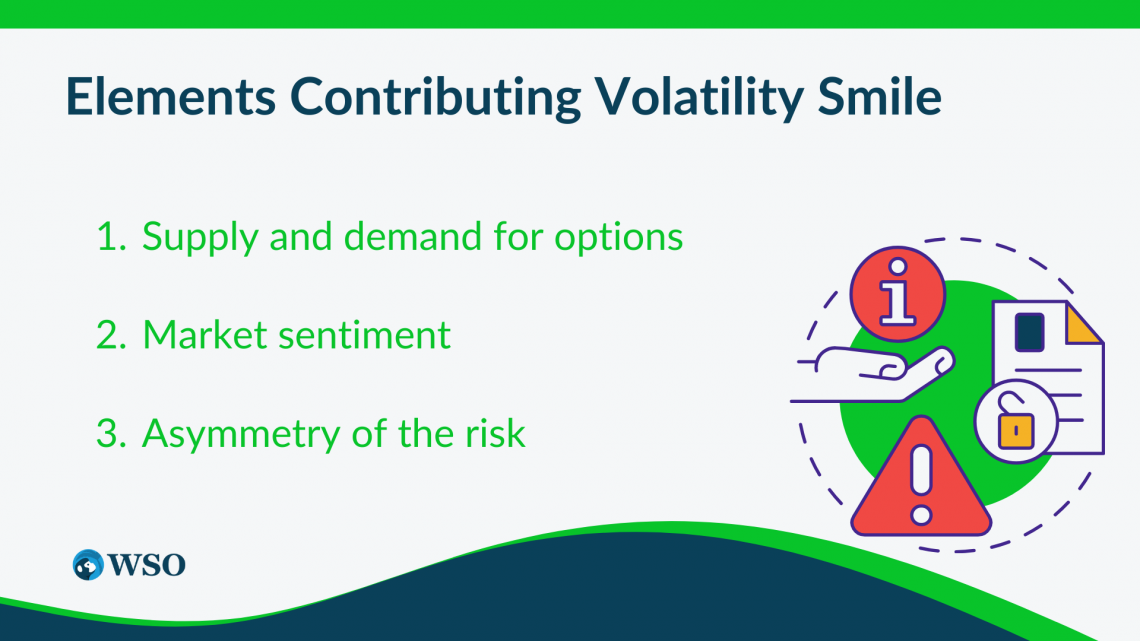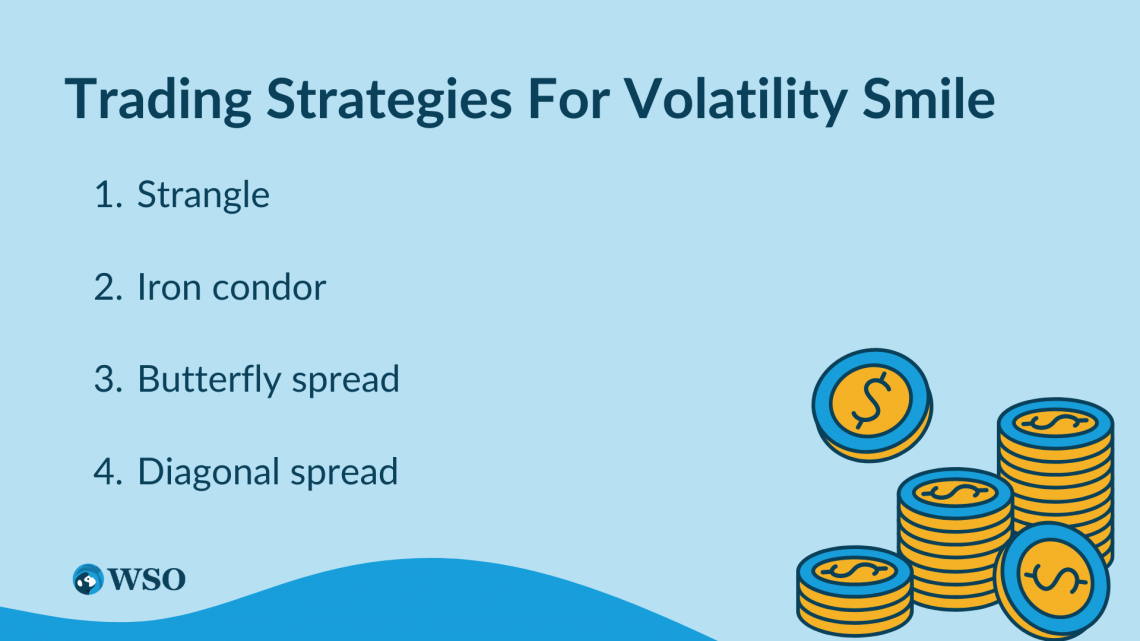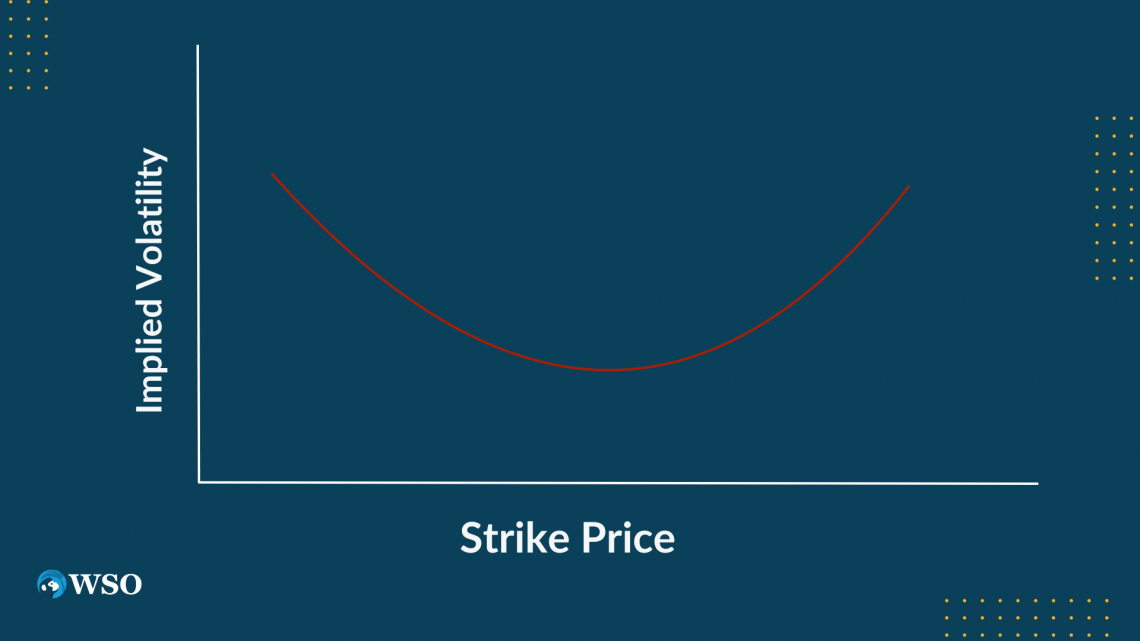Volatility Smile
It is particularly relevant for two types of options: equity options and foreign currency options.
What is a Volatility Smile?
The volatility smile is a term used in finance to describe a graphical pattern or curve that depicts the implied volatility of financial options with different strike prices but the same expiration date.

The world of options trading can be complex and challenging, with countless variables to consider when evaluating potential investments. Implied volatility, which reflects the anticipated future volatility of the underlying asset, stands as one of the key determinants in option pricing.
This is not always a straightforward concept despite its importance. The market often shows a curious phenomenon known as the volatility smile, which has puzzled traders and analysts for decades.
It is a phrase utilized to depict the configuration of implied volatility for options of the identical underlying asset but with varying exercise prices and maturity dates.
In a perfect world, the implied volatility for all options would follow a smooth curve, with higher volatility for options that are further from the current market price and longer-dated. However, it often deviates from this curve and creates a distinctive smile-like shape.
This deviation occurs because options traders are willing to pay more for the right to buy or sell an asset at a specific price in certain market conditions, resulting in the supply and demand for options skewing the implied volatility. Academics, traders, and analysts have studied this concept extensively.

One of the earliest papers on the topic was published by Emanuel Derman and Iraj Kani in 1994, who found that it could not be explained by the standard Black-Scholes model that assumes constant volatility.
Instead, they proposed a new model incorporating stochastic volatility to better reflect the behavior of real markets.
Since then, many researchers have attempted to explain the VS by observing various factors, including supply and demand, market sentiment, and macroeconomic events. This is particularly relevant for two types of options: equity options and foreign currency options.

For equity options, this can be affected by factors such as company earnings announcements, mergers and acquisitions, or changes in the broader market sentiment.
Fluctuations can influence foreign currency options in exchange rates, interest rate differentials, and geopolitical events that impact global trade and commerce.
Understanding is essential for options traders who want to price their investments accurately and make informed decisions about trading strategies.
It can furnish valuable insights regarding market sentiment and prospective hazards, enabling traders to adapt their portfolios correspondingly.
Key Takeaways
- The term 'volatility smile' is employed to depict the arrangement of implied volatility for options belonging to the identical underlying asset but exhibiting different strike prices and expiration dates.
- The standard Black-Scholes model could not explain the volatility smile.
- It is particularly relevant for two types of options: equity options and foreign currency options.
- Traders must understand the various trading strategies that can be used to take advantage of this market phenomenon.
- The volatility smile for equity options reflects the market's perception of the risk and return characteristics of the underlying stocks.
Understanding the volatility smile
It's important to understand implied volatility and how it is used to price options. Implied volatility designates the market's expectation of how volatile an asset's price will be over a given period.

It is calculated by reverse-engineering the Black-Scholes pricing model, which uses various inputs, such as the underlying asset's price, the option's strike price, and time to expiration, to estimate the option's fair value.
The Black-Scholes model assumes that implied volatility is constant across all options of the same asset, regardless of the option's strike price or expiration date.
However, in practice, options traders often demand higher implied volatility for options that are further from the current market price and have longer expiration dates. This leads to the creation of the volatility smile.
It shows that the implied volatility for OTM ("out-of-the-money") options is higher than for ATM ("at-the-money") options. In some cases, the implied volatility for ITM ("in-the-money") options can also be higher than for ATM options.
Note
This pattern is not uniform and can vary depending on market conditions. However, the general trend is for the implied volatility to curve upwards towards higher strike prices, creating a smile-like shape.
It is a distinct deviation from the Black-Scholes model, signifying that the market perceives implied volatility as not uniform across all options. There exist multiple elements that can contribute to the establishment of it.
Some of the elements contributing to volatility smile are:

1. Supply and demand for options
One is the supply and demand for options, which can impact their prices and implied volatility. If there is an unexpected increase in demand for OTM options, their prices and implied volatility will increase too.
2. Market sentiment
Another aspect is market sentiment, as traders may be more willing to pay higher prices for options during uncertain or market turbulence. Macroeconomic events can also play a role in forming the volatility smile.
For instance, a sudden shift in interest rates or a significant political development can cause the market to reassess the expected volatility of an asset, leading to changes in the implied volatility of options.
3. Asymmetry of the risk
Additionally, it can reflect the asymmetry of the risk of the underlying asset. Suppose the asset is more likely to experience large negative returns. In that case, the implied volatility for OTM puts will be higher, causing the left side of the volatility smile to be steeper.
Note
This is an important phenomenon to understand in options trading.
It indicates that the market's perception of implied volatility is more complex than what the Black-Scholes model captures and that traders must consider a range of aspects when pricing options.
By analyzing it, traders can gain insights into market sentiment, assess potential risks and rewards, and make more informed trading decisions.
Volatility Smile For Equity Options
EQs are contracts that offer the holder the right to trade a specific stock at a predetermined price and time. Like all options, their prices are heavily influenced by implied volatility, and it can significantly impact how equity options are priced.

One of the main reasons in equity options is the skewness of the return distribution of the underlying stocks. Equity returns are usually skewed to the left.
It means that the probability of experiencing large negative returns is higher than the probability of experiencing large positive returns. This is due to factors such as market crashes, earnings surprises, and geopolitical events that can significantly negatively impact a stock's price.
As a result, the implied volatility for OTM puts, which protect against these negative events, tends to be higher than for OTM calls, leading to a steeper left-hand side.
Note
Supply and demand dynamics can also influence the right-hand side for equity options.
Options traders often demand higher implied volatility for OTM calls that are far from the current market price, as they are viewed as potential high-reward opportunities.
This can result in higher implied volatility for these options, leading to a flatter right-hand side. Another factor that can impact the volatility smile for equity options is the sector and market capitalization of the underlying stocks.
For example, large-cap stocks that are part of popular indices such as the S&P 500 may have more liquid and efficient options markets, leading to a more pronounced volatility smile.
The impact of this on equity options pricing can be significant. For example, during the financial crisis of 2008, it became more pronounced, with the implied volatility for OTM spiking to levels not seen since the 1987 crash.
Note
Stocks in certain sectors, such as technology or biotech, which are known for their high volatility and potential for sudden movements, may also exhibit more pronounced volatility smiles.
This led to a surge in demand for equity put options as investors sought to protect themselves against further market downturns. The increased demand for these options led to a sharp increase in their prices, causing the implied volatility smile to become even steeper.
They reflect the market's perception of the risk and return characteristics of the underlying stocks. It can be influenced by a range of elements, including:
- The skewness of the return distribution
- Supply and demand dynamics
- The sector and market capitalization of the stocks
It is essential for options traders looking to price equity options accurately and assess potential risks and rewards.
Volatility Smile For Foreign Currency Options
Foreign currency options are contracts that offer the holder the right to acquire or vend a particular currency at a predetermined price and time.

These options are widely used by businesses and investors to hedge against currency risk and speculate on currency movements. One of the main reasons in foreign currency options is the asymmetric nature of currency movements.
Unlike equities with a positive skew due to the potential for significant price gains, currencies can move in either direction with equal probability.
Currency movements are generally influenced by events such as central bank decisions, economic data releases, and geopolitical tensions, which can cause sudden and significant price movements.
As a result, the implied volatility for OTM puts and calls tends to be higher than for ATM options, leading to a U-shaped smile.
Note
Like equity options, their prices are heavily influenced by implied volatility, and the volatility smile can significantly impact how they are priced.
Another aspect that can impact the foreign currency options is interest rate differentials. Between two currencies, this aspect can have a notable impact on the exchange rate and the value of the options.
Higher interest rates in one country relative to another will increase demand for that country's currency, conducting to an appreciation in its value. This can result in a flatter right-hand side, as options traders demand less implied volatility for OTM calls.
Note
The impact of natural disasters on foreign currency options pricing can be significant, especially for businesses and investors looking to hedge their currency risk.
Besides, a large interest rate differential can also lead to higher volatility as traders speculate on potential central bank interventions or sudden changes in monetary policy. Geopolitical factors and market sentiment can also influence the volatility smile for foreign currency options.
For example, traders may demand higher implied volatility for options during heightened uncertainty and risk aversion, leading to a steeper left-hand side.
Similarly, sudden changes in the political landscape or unexpected events such as natural disasters can lead to sharp currency movements and more pronounced volatility smiles.
Mispricing options due to a misunderstanding of the volatility smile can result in significant losses or missed opportunities.

During the Swiss franc crisis of 2015, many shareholders suffered heavy losses as the Swiss National Bank unexpectedly removed the cap on the franc's value against the euro, causing a sudden and significant appreciation in its value.
Those who had mispriced their options due to misunderstanding this suffered significant losses, while others who had correctly anticipated the currency movements could profit significantly.
It reflects the market's perception of specific currencies' risk and return characteristics. It can be influenced by a range of factors, including:
- The asymmetric nature of currency movements
- Interest rate differentials
- Geopolitical factors
- Market sentiment
Trading Strategies For Volatility Smile
Strategies are important when trading options, as they can significantly impact pricing and risk management.

To effectively trade options with a volatility smile, traders must understand the various trading strategies that can be used to take advantage of this market phenomenon.
Here is the representation of the volatility smile:

Some of the trading strategies for volatility smile are:
1. Strangle
A strangle is an options strategy where a trader buys both a put option and a call option with the same expiration date but different strike prices.
The exercise price of the put option is consistently lower than the prevailing market price, whereas the exercise price of the call option is typically higher. By buying both options, the trader is betting on a significant movement in either direction.
When there is a “s,” the premiums of both the put and the call options are likely to be higher, providing an opportunity for traders to make a profit.
2. Iron condor
This strategy demands selling both a call option and a put option while acquiring a call option and a put option with a higher and lower strike price, respectively.
The idea behind the iron condor is to create a range of potential price movements where the trader can profit while also limiting their potential losses.
Note
When there is volatility smile, the premiums of the sold options are likely to be higher, providing an opportunity for traders to make a profit.
3. Butterfly spread
To execute a butterfly spread, one must purchase a call option with a reduced exercise price, sell two call options with an elevated exercise price, and subsequently acquire a call option with an even more elevated exercise price.
The same can be done with put options. This strategy authorizes traders to profit if the underlying asset's price stays within a specific range while limiting their potential losses.
When there is a volatility smile, the premiums of the options used in the butterfly spread are likely to be higher, providing an opportunity for traders to make a profit.
4. Diagonal spread
A diagonal spread consists in purchasing a long-lived option with a strike price a bit higher or lower than the current market price while also selling a shorter-term option with a greater or lower strike price.
This strategy enables traders to take advantage of it by selling the shorter-term option at a higher premium while also reducing their overall risk by holding a longer-term option.
Note
Traders can employ other strategies to take advantage of the volatility smile, such as vertical spreads, calendar spreads, or delta-neutral strategies.
Numerous trading methodologies exist that can be employed to exploit the volatility smile while engaging in options trading. These include the strangle, iron condor, butterfly spread, and diagonal spread.
Each strategy has its benefits and disadvantages, and traders must carefully consider their goals and risk tolerance.
By understanding the volatility smile and how it affects options pricing, traders can increase their chances of making profitable trades and managing their risk effectively.
Conclusion
The volatility smile is a market phenomenon that occurs when options with the same expiration date but different strike prices have different implied volatilities.

It is a vital component to consider when engaging in options trading, as it can significantly influence pricing and risk management.
While it is regularly observed in equity options, it can also appear in other types of options, such as foreign currency options. The specific causes and implications of this can vary depending on the underlying asset, market conditions, and other factors.
Traders can use various strategies to take advantage of it when trading options. These include the strangle, iron condor, butterfly spread, and diagonal spread.
Comprehending the VS is a crucial concept for traders to grasp when trading options.
By carefully analyzing the implied volatility of different options and considering the implications of the volatility smile, traders can make more informed decisions and better manage their risk.
Note
It is an important market phenomenon that can provide valuable insights into options' pricing and risk management.
Through careful examination of the origins and ramifications of the volatility smile, along with the diverse tactics that can be employed to capitalize on it, traders can enhance their prospects of executing profitable trades and effectively managing risk.
While the markets evolve and novel factors emerge, it will retain its significance as a concept for traders to consider and integrate into their trading strategies.
If you're interested in the concept of smile volatility, you might like to read the following thesis written by Brian Michel Butler: THE BLACK SCHOLES FORMULA AND VOLATILITY SMILE.




or Want to Sign up with your social account?